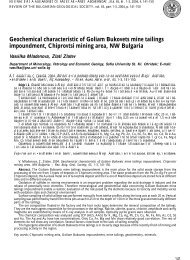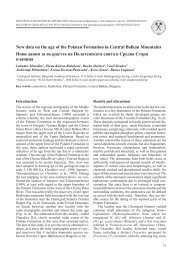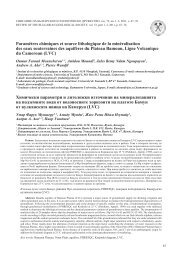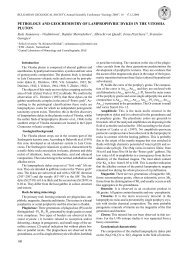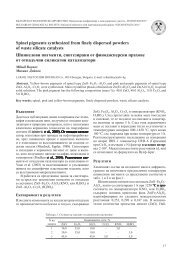First find of nephrite in tremolitite body from Ograzhden Mountain ...
First find of nephrite in tremolitite body from Ograzhden Mountain ...
First find of nephrite in tremolitite body from Ograzhden Mountain ...
You also want an ePaper? Increase the reach of your titles
YUMPU automatically turns print PDFs into web optimized ePapers that Google loves.
БЪЛГАРСКО ГЕОЛОГИЧЕСКО ДРУЖЕСТВО, Национална конференция с международно участие „ГЕОНАУКИ 2010“<br />
BULGARIAN GEOLOGICAL SOCIETY, National Conference with <strong>in</strong>ternational participation “GEOSCIENCES 2010”<br />
<strong>First</strong> <strong>f<strong>in</strong>d</strong> <strong>of</strong> <strong>nephrite</strong> <strong>in</strong> <strong>tremolitite</strong> <strong>body</strong> <strong>from</strong> <strong>Ograzhden</strong> Mounta<strong>in</strong>,<br />
Southwestern Bulgaria<br />
Първа находка на нефрит в тремолититово тяло от Огражден планина,<br />
ЮЗ България<br />
Nikola Zidarov 1 , Ruslan I. Kostov 2 , Petar Zidarov 3<br />
Никола Зидаров 1 , Руслан И. Костов 2 , Петър Зидаров 3<br />
1 Institute <strong>of</strong> M<strong>in</strong>eralogy and Crystallography, Bulgarian Academy <strong>of</strong> Sciences, 1113 S<strong>of</strong>ia; E-mail: nzidarov@<strong>in</strong>terbgc.com<br />
2 University <strong>of</strong> M<strong>in</strong><strong>in</strong>g and Geology “St. Ivan Rilski”, 1700 S<strong>of</strong>ia, Bulgaria; E-mail: rikostov@yahoo.com<br />
3 New Bulgarian University, 1618 S<strong>of</strong>ia, Bulgaria; E-mail: petar.zidarov@yahoo.com<br />
Key words: <strong>nephrite</strong>, tremolite, act<strong>in</strong>olite, nephritization, SW Bulgaria.<br />
Nephrite is a fiber cryptocrystall<strong>in</strong>e massive variety<br />
with composition <strong>in</strong> the tremolite Ca 2 Mg 5 Si 8 O 22 (OH) 2<br />
to ferroact<strong>in</strong>olite Ca 2 Fe 5 Si 8 O 22 (OH) 2 amphibole series<br />
(Hawthorne, 1981). Nephrite deposits are associated<br />
worldwide ma<strong>in</strong>ly with serpent<strong>in</strong>ite units with<strong>in</strong><br />
ophiolite belts or with dolomite marbles as a product <strong>of</strong><br />
metasomatic processes (Sutur<strong>in</strong>, Zamaletd<strong>in</strong>ov, 1984).<br />
Nephrite takes a specific role <strong>in</strong> the history <strong>of</strong><br />
human civilization. It is one <strong>of</strong> the first raw m<strong>in</strong>eral<br />
materials used for prehistoric stone tools (axes, adzes<br />
and chisels), prestigious <strong>in</strong>signia, amulets and other<br />
juwellery artefacts. Nephrite artefacts are found on the<br />
Balkans with highest concentration on the territory <strong>of</strong><br />
contemporary Bulgaria, <strong>from</strong> the Early Neolithic to<br />
the end <strong>of</strong> the Chalcolithic period (end <strong>of</strong> VII mill.<br />
BC – middle <strong>of</strong> V mill. BC), which is the reason for<br />
<strong>in</strong>troduc<strong>in</strong>g a Balkan “<strong>nephrite</strong> culture”, probably<br />
one <strong>of</strong> the earliest <strong>in</strong> mank<strong>in</strong>d, earlier and before the<br />
well known Ch<strong>in</strong>ese Neolithic <strong>nephrite</strong> yield<strong>in</strong>g cultures<br />
(Kostov, 2007). On the territory <strong>of</strong> Bulgaria<br />
such <strong>nephrite</strong> artefacts are found ma<strong>in</strong>ly <strong>in</strong> the prehistoric<br />
sites along the Struma River valley, <strong>in</strong> Central<br />
Bulgaria, the Eastern Rhodopes and <strong>in</strong> Northeastern<br />
Bulgaria (Todorova, Vaisov, 1993). Despite the numerous<br />
<strong>nephrite</strong> archaeological <strong>f<strong>in</strong>d</strong>s on the Balkans,<br />
no <strong>in</strong> situ deposits or occurrences have been described<br />
<strong>in</strong> geological or m<strong>in</strong>eralogical papers. The geological<br />
sett<strong>in</strong>g for such deposits and occurrences <strong>in</strong> Bulgaria<br />
and some other Balkan countries is favourable with a<br />
lot <strong>of</strong> serpent<strong>in</strong>ized ultramafic rock outcrops.<br />
The aim <strong>of</strong> this communication is the observation<br />
and description <strong>of</strong> an occurrence <strong>of</strong> <strong>nephrite</strong> bear<strong>in</strong>g<br />
<strong>tremolitite</strong> <strong>body</strong>, which gives a h<strong>in</strong>t for the idea that<br />
<strong>in</strong> SW Bulgaria there are conditions for the formation<br />
and future <strong>f<strong>in</strong>d</strong><strong>in</strong>g <strong>of</strong> <strong>nephrite</strong> deposits related to the<br />
rocks <strong>of</strong> the ultramafic genetic type.<br />
Occurrence<br />
Nephrite is found among the m<strong>in</strong>erals <strong>of</strong> a small<br />
talc-tremolitic <strong>body</strong> <strong>in</strong>cluded <strong>in</strong> metamorphic rocks<br />
cropp<strong>in</strong>g out <strong>in</strong> the <strong>Ograzhden</strong> Mounta<strong>in</strong>, along the<br />
Lebnitsa River valley.<br />
Geological sett<strong>in</strong>g<br />
The <strong>in</strong>vestigated talc-tremolitic <strong>body</strong> is <strong>in</strong>corporated<br />
<strong>in</strong> non-uniformly -uniformly uniformly migmatized migmatized migmatizedmigmatized biotite biotite biotite gneisses gneisses gneissesgneisses (meta- (meta(meta(meta-<br />
(meta- (metametagranites<br />
with a protolith age ~ 460 Ma) constitut<strong>in</strong>g the<br />
metamorphic complex, build<strong>in</strong>g the <strong>Ograzhden</strong> unit <strong>of</strong><br />
the Serbo-Macedonian Massif to the west <strong>of</strong> the Struma<br />
River (Zagorchev, 2001). They are metamorphosed <strong>in</strong><br />
the amphibolite facies with a Variscan age (336±3.7<br />
Ма accord<strong>in</strong>gtotodatadata<strong>of</strong><strong>of</strong> the thethe U-Pb U-Pb U-Pb method method method method method method for for forfor for xenoxeno-<br />
xeno- xenoxenoxenotime),<br />
and <strong>in</strong> certa<strong>in</strong> episods are related to the Alp<strong>in</strong>e<br />
magmatic activity and change <strong>of</strong> the tectonic regime,<br />
with a lower <strong>in</strong> degree metamorphism (Zidarov et al.,<br />
2009). In some parts <strong>of</strong> the metamorphic complex are<br />
registered garnet-mica schists (Macheva et al., 2005),<br />
metamorphosed ultramafic and mafic rocks rocks (serpen- (serpen(serpenserpent<strong>in</strong>ized<br />
peridotites and/оr harzburgites, cl<strong>in</strong>opyroxenites<br />
and websterites, , oliv<strong>in</strong>e gabbro-norites and leucoleucocratic gabbros), which are metamorphosed to eclogites<br />
and latter on to amphibolites (Zidarov, Nenova, 1995).<br />
The Igralishte and Nikud<strong>in</strong> granitoid plutons with an<br />
age about 243 Ma (Peycheva et al., 2009) as well as<br />
volcanic dacitic bodies about 32 Ma old (Pecskay et<br />
al., 2001) are <strong>in</strong>truded <strong>in</strong> the metamorphic complex.<br />
Description <strong>of</strong> the talc-tremolite <strong>body</strong><br />
The talc-tremolite <strong>body</strong> is elongated <strong>in</strong> a northwestsoutheast<br />
direction with a lens shape form. Its length<br />
is about 10 m, width <strong>in</strong> the central part – 2–2.5 m and<br />
at the term<strong>in</strong>al parts – 0.5 m. It is subconcordant accord<strong>in</strong>g<br />
the host biotite gneisses, which envelop it,<br />
and their crystallization schistosity is subparallel to<br />
the outl<strong>in</strong>e <strong>of</strong> the <strong>body</strong> and its schistosity, dipp<strong>in</strong>g to<br />
the north-east at a ~70° angle. At the lower contact<br />
<strong>of</strong> the <strong>body</strong> is observed an up to 10 mm thick biotite<br />
zone with striations, witness<strong>in</strong>g its tectonic transport,<br />
as well as small biotitized amphibolite lenses. The<br />
33
ody has a zonal composition with two ma<strong>in</strong> zones:<br />
Talc zone which is built by talc (about 90%), prismatic<br />
tremolite <strong>in</strong>dividuals, nestiform segregations <strong>of</strong> sericite,<br />
radiate margarite flake aggregates and muscovite<br />
flakes. Chlorite-margarite-tremolite zone. It consti- consti-<br />
tutes the larger part <strong>of</strong> the <strong>body</strong>. The colour <strong>of</strong> the zone<br />
is green to yellow-green, with a radiated structure and<br />
a comb<strong>in</strong>ation <strong>of</strong> nematoblastic, sheaf-like and fibroblastic<br />
texture. The tremolite (75–80%) is observed<br />
as long to f<strong>in</strong>e prismatic aggregates. In the latter are<br />
observed f<strong>in</strong>e fibers (<strong>nephrite</strong>). The margarite (about<br />
20%) is distributed <strong>in</strong> nests as radiated aggregate<br />
flakes. Observed are also relict amphibole and Mg-<br />
Fe chlorite, as well as biotite flakes <strong>in</strong> the tremolite at<br />
the lower part <strong>of</strong> the <strong>body</strong>. Accord<strong>in</strong>g to the m<strong>in</strong>eral<br />
composition, the described aggregate can be denoted<br />
as <strong>nephrite</strong> bear<strong>in</strong>g <strong>tremolitite</strong>.<br />
M<strong>in</strong>eralogical data<br />
The tremolite and act<strong>in</strong>olite aggregates aggregates are areheteroheteroheterogra<strong>in</strong>ed, built by prismatic <strong>in</strong>dividuals. Most <strong>of</strong> the<br />
gra<strong>in</strong>s are elongated <strong>in</strong> one and the same direction,<br />
but there are also some which are orientated oblique<br />
or under an angle toward the elongation. They are<br />
cracked along and across their elongation. Needle like<br />
<strong>in</strong>dividuals with a length up to 1.5 cm are observed, as<br />
well as aggregates with radiated or sheaf-like texture.<br />
Under the microscope <strong>in</strong> th<strong>in</strong> sections the tremolite is<br />
transparent, colourless to pale green (<strong>in</strong> the richer to<br />
iron <strong>in</strong>dividuals), which causes a spotted distribution<br />
<strong>of</strong> thethegraygreen graygreen colour. colour. . The The ext<strong>in</strong>ction ext<strong>in</strong>ction angle angle c: c:c: c: Z Z Z Z var<br />
var- varvar-<br />
var- varies<br />
<strong>from</strong> 15–18° <strong>in</strong> tremolite to 19–20° <strong>in</strong> act<strong>in</strong>olite.<br />
Areas with a <strong>nephrite</strong> (nematoblastic, fibroblastic)<br />
texture are observed among thetheaggregatesaggregates aggregates <strong>of</strong> <strong>of</strong> <strong>of</strong> tremtremtremolite,<br />
which are distributed <strong>in</strong> irregular forms or as<br />
small lenses with dimension <strong>of</strong> a few mm2 . They are<br />
composed by densely <strong>in</strong>terlocked and twisted fibers,<br />
usually gathered <strong>in</strong> micr<strong>of</strong>iber sheaves, with a cross<br />
section <strong>of</strong> about 2.5 μm and length up to 0.3 mm, and<br />
built up by sub<strong>in</strong>dividuals, each <strong>of</strong> which with a width<br />
under 1 μm – well observed at their free term<strong>in</strong>al part.<br />
References<br />
Hawthorne, F. C. 1981. Reviews <strong>in</strong> M<strong>in</strong>eralogy. 9A. Amphiboles<br />
and Other Hydrous Pyriboles. – In: Veblen, D. R. (Ed.).<br />
M<strong>in</strong>eralogy. M<strong>in</strong>eralogical Society <strong>of</strong> America, 1–102.<br />
Kostov, R. I. 2007. Archaeom<strong>in</strong>eralogy <strong>of</strong> Neolithic and<br />
Chalcolithic Artefacts <strong>from</strong> Bulgaria and their Significance<br />
to Gemmology. S<strong>of</strong>ia, Publish<strong>in</strong>g House “St. Ivan Rilski”,<br />
I-VIII, 126 p. (<strong>in</strong> Bulgarian with an English summary).<br />
Macheva, L., R. Titorenkova, N. Zidarov. 2005. Kyanitestaurolite-garnet-bear<strong>in</strong>g<br />
schists <strong>from</strong> <strong>Ograzhden</strong> mouta<strong>in</strong>,<br />
SW Bulgaria - metapelites or orthoschists? – In: Proc. <strong>of</strong><br />
Jub. Inter. Conf. “80 Years Bulgarian Geological Society”.<br />
S<strong>of</strong>ia, 138–141.<br />
Pecskay, Z., A. Harkovska, N. Zidarov, I. Zagorchev, M. Popov,<br />
V. Panteva. 2001. K-Ar dat<strong>in</strong>g <strong>of</strong> the tertiary volcanic rocks<br />
<strong>from</strong> Ograzden and Maleshevska mounta<strong>in</strong>s, SW Bulgaria.<br />
– C. R. Acad. bulg. Sci., 54, 4, 71–76.<br />
Peycheva, I., A. von Quadt, M. Tarassov, N. Zidarov, E.<br />
Tarassova, , V. . Andreichev. Andreichev. . 2009. 2009. 2009. Tim<strong>in</strong>g Tim<strong>in</strong>g Tim<strong>in</strong>g <strong>of</strong> <strong>of</strong> <strong>of</strong> Igralishte Igralishte Igralishte plu-<br />
plu- plu-<br />
plu-<br />
34<br />
Such curved and hair-like f<strong>in</strong>e crystallites are known<br />
as trichites. Their genesis is related to the metasomatic<br />
replacement <strong>of</strong> the prismatic tremolite <strong>in</strong>dividuals by<br />
nephritic whiskers and aggregates. . The front<strong>of</strong> <strong>of</strong> metameta<br />
meta- meta-<br />
meta-<br />
somatic replacement is polycentric, <strong>in</strong> the form <strong>of</strong><br />
nuclei, which transform <strong>in</strong>to spots with the progress<br />
<strong>of</strong> the process. The nephritization process penetrates<br />
along the boundaries <strong>of</strong> the tremolite <strong>in</strong>dividuals and<br />
homoaxialy along their cleavage planes as well as<br />
along some transversely to the elongation cracks.<br />
Chemical composition<br />
The microprobe analyzed areas <strong>of</strong> the <strong>nephrite</strong> fibers<br />
correspond to a composition with empirical formulae<br />
Ca 1.936 K 0.027 Mg 4.318 Mn 0.034 Fe 0.711 Ti 0.026 Si 7.912 O 22 (OH) 2<br />
and Ca 1.332 Na 0.034 K 0.010 Ba 0.008 Mg 4.470 Mn 0.102 Fe 1.079 Ti 0.020<br />
Si 7.972 O 22 (OH) 2. Accord<strong>in</strong>g to the Mg/(Mg+Fe 2+ ) to Si<br />
(per formula unit) classification diagram (Hawthorn,<br />
1981) the amphibole compositions are very close to<br />
tremolite-act<strong>in</strong>olite boundary <strong>of</strong> 0.9.<br />
XRD data<br />
The powder XRD analysis reveals that the studied<br />
m<strong>in</strong>eral corresponds to tremolite (compared to PDF<br />
850876). ). . The strongest reflections <strong>in</strong> the powder dif- diffraction<br />
pattern are (d <strong>in</strong> Å, I observed): 8.35, 100;<br />
4.18, 15; 3.26, 10; 3.11, 60; 2.80, 16.<br />
M<strong>in</strong>eral form<strong>in</strong>g conditions<br />
The genesis <strong>of</strong> the <strong>body</strong> is a result <strong>of</strong> replacement <strong>of</strong><br />
amphibolites, formed on the basis <strong>of</strong> Precambrian<br />
ophiolites and Cadomian eclogites <strong>in</strong> the amphibolite<br />
facies dur<strong>in</strong>g the Variscan metamorphism. The process<br />
<strong>of</strong> diaphtoresis is isochemical and has place under<br />
greenschist facies conditions, related to the activation<br />
<strong>of</strong> the fluid regime at the time <strong>of</strong> the <strong>in</strong>trusion <strong>of</strong> the<br />
nearby located Igralishte and Nikud<strong>in</strong> granite plutons.<br />
The nephritization <strong>of</strong> the tremolite is caused by modulation<br />
<strong>in</strong> its structure and heterogenic nucleation at the<br />
defect sites <strong>of</strong> its structure.<br />
ton <strong>in</strong> <strong>Ograzhden</strong> mounta<strong>in</strong>, SW Bulgaria: implications for<br />
the tectono-magmatic evolution <strong>of</strong> the region. – Geologica<br />
Balc., 37, 3–4, 5–14.<br />
Sutur<strong>in</strong>, N. A., P. S. Zamaletd<strong>in</strong>ov. 1984. Nephrites.<br />
Novosibirsk, Nauka, 150 p. (<strong>in</strong> Russian).<br />
Todorova, H., I. Vaisov. 1993. The New Stone Age <strong>in</strong> Bulgaria.<br />
S<strong>of</strong>ia, Nauka i Izkustvo, 288 p. (<strong>in</strong> Bulgarian).<br />
Zagorchev, I. 2001. Geology <strong>of</strong> SW Bulgaria: an overview. –<br />
Geologica Balc., 21, 1–2, 3–52.<br />
Zidarov, N., P. Nenova. 1995. Basic and ultrabasic rocks<br />
and related eclogites <strong>from</strong> the Serbo-Macedonian massif<br />
(South-Western Bulgaria). – In: Proc. <strong>of</strong> the XV Congr. <strong>of</strong><br />
the CBGA, Spec. Publ., 4. Geol. Soc. Greece, 619–626.<br />
Zidarov, N., V. Andreichev, I. Peytcheva. 2009. Rb-Sr isotope<br />
data on Variscan and Alp<strong>in</strong>e polymetamorphic evolution <strong>of</strong><br />
the granitoids <strong>from</strong> the <strong>Ograzhden</strong> unit <strong>in</strong> SW Bulgaria. –<br />
In: Proc. National Conference “Geosciences 2009”. S<strong>of</strong>ia,<br />
Bulg. Geol. Soc., 27–28 (<strong>in</strong> Bulgarian).




